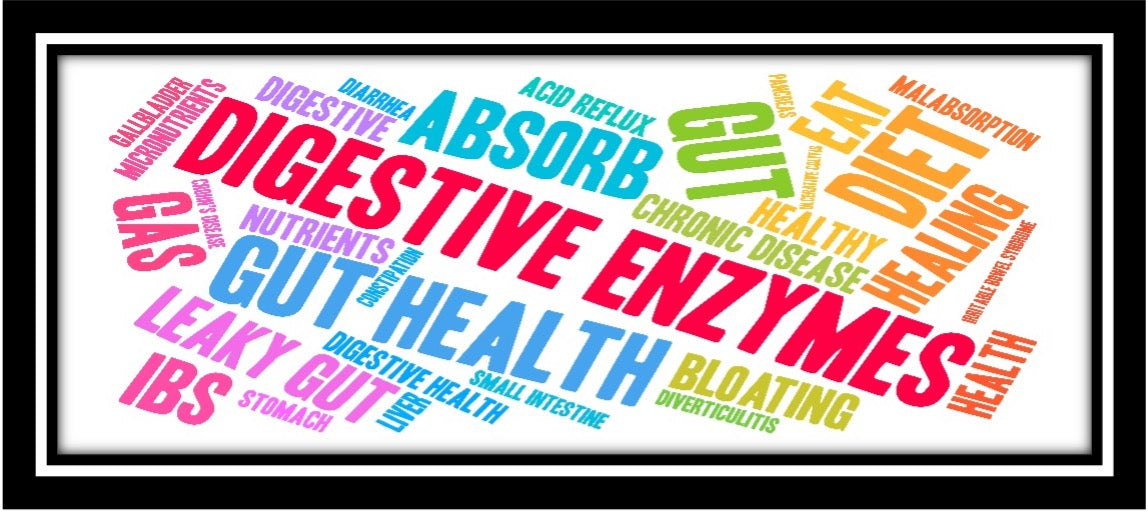Life Wouldn’t Exist if it Wasn’t for These

The power of digestive enzymes
How does our body turn that delicious meal we just ate into the building blocks needed to keep our body healthy and functioning?
Why after a large meal do we sometimes get indigestion?
Why do we get excessive gas after eating certain foods?
Only a few decades back the medical community regarded our digestive system as a large tube that mixed digestive juices together, broke down food and moved the food along its passage, absorbing nutrients in the intestine as it traveled down the alimentary canal.
Until recently the complex interaction of chemicals, hormones, genetics, and how it affects the overall health of a person wasn’t given much thought, as far as gut health was concerned.
Over the past decade, science has made tremendous strides in learning about the function of the gastrointestinal system.
All health begins in the gut
Probiotics, Prebiotics, Digestive enzymes
The gastrointestinal tract (GIT) track is one of the most complex organ systems in the body. A brief overview of the physiology (what makes the GI track work) of the gut includes:
- Hormones Known as the largest endocrine organ in the body (glands that secrete hormones) there are more than 50 known gut hormone genes and bioactive peptides. Some of the better-known gut hormones are gastrin, secretin, and cholecystokinin (CCK). These hormones play a role in maintaining gut wall integrity, and vagus nerve performance (part of the parasympathetic nervous system, controls resting heart rate, respiration, digestion, and much more). Other GIT hormones, such as ghrelin, play a role in hunger in satiety signals (1,2)
- Beneficial bacteria(probiotics) Probiotics are recognized for their capacity to produce beneficial enzymes that aid in digestion and protect the gastrointestinal tract (GIT). Probiotics help to maintain a balance between the ‘good’ and the ‘bad’ gut bacteria, which leads to improved activity of digestive enzymes, ability to absorb nutrients, and reduced pathogenic issues in the GIT. (3)
Examples of probiotic-rich foods include kefir, yogurt, fermented veggies, and kombucha
- Food for the bacteria(prebiotics) Prebiotics, often in the form of non-digestible
carbohydrates like fructooligosaccharides (FOS) and inulin, serve as substrates for beneficial gut bacteria. Small-chain fatty acids (SCFA) are also manufactured and can influence gut health. Prebiotics contribute to the maintenance of a balanced microbial community in the gut. A well-balanced microbiota is essential to produce certain enzymes that aid in the digestion and absorption of nutrients and a way for the body to break down and absorb nutrients (through digestive enzymes). (3)
Examples of prebiotic foods include fiber-rich fruits and vegetables (apples with skin on, berries, Jerusalem artichokes, almost all non-starchy veggies, and whole grains.
- Synbiotics refer to the combination of probiotics and prebiotics, creating a synergistic effect to enhance the health-promoting benefits in the body. Synbiotics work to balance the gut microbial community, which in turn can enhance the production and activity of digestive enzymes. (3)
- Digestive enzymes play a crucial role in breaking down food into their tiniest sizes for efficient absorption via the body, energy metabolism, and overall health. They are produced when the gut flora is in balance. (3)
An out-of-balance gut leads to chronic diseases and cancer, and even our emotional health is affected.

Digestive enzymes- the byproduct of a balanced gut
Digestive enzymes are found throughout the digestive system and are produced by various organs and glands
Types of Digestive Enzymes
There are different types of digestive enzymes that break down different types of food. Each type of enzyme has under it other specialized enzymes that aid in the digestion of different types of foods fats, proteins, and carbohydrates. These are:
- Protease- breaks down proteins into amino acids and plays a role in growth and hormone signaling.
- Lipase breaks down triglycerides into free fatty acids and glycerol.
- Amylase- Breaks down carbohydrates and starches into simple sugars.
Locations of Digestive Enzymes (4)
- Mouth: Carbohydrates-Salivary glands produce amylase, which begins the digestion of carbohydrates.
- Stomach: Proteins and fat enzymes-Chief cells in the stomach produce pepsinogen, which is activated into pepsin (a protease) by stomach acid.
Fats- Gastric lipase is also produced in the stomach.
Stomach enzymes work best in an acidic environment. Sometimes diluted apple cider vinegar (1 tbsp in a large glass of water, never take undiluted) can aid in digestion.
- Pancreas- The main source of digestive enzymes:
As an exocrine gland, the pancreas releases substances that neutralize stomach acid. It also secretes digestive enzymes that break down proteins, fats, and carbohydrates.
If the pancreas is unable to produce sufficient enzymes, a condition called exocrine pancreatic insufficiency (EPI) can cause poor digestion, and in some cases, malnutrition. The most common causes of EPI are pancreatitis and cystic fibrosis.
- Small Intestine: Proteins, fat, and carbohydrates- The walls of the small intestine produce different types of protein, fat, and carbohydrate enzymes to further break down food particles, making them available for the body to use.
- Liver- Produces bile (not an enzyme but very important) and is stored in the gallbladder. This aids in fat digestion by emulsifying fats, making it easier for digestive enzymes to break down fats.
Factors affecting digestive enzyme production
- Aging
- Poor diet
- Medications (proton pump inhibitors, for example)
- Alcohol consumption
- Gastrointestinal disorders- irritable bowel syndrome. Crohn’s disease, celiac, ulcerative colitis (4)
Symptoms of digestive enzyme deficiency (5)
- Trouble digesting food (as in lactose intolerance or after eating a big meal- heartburn, acid reflux)
- Excess gas or bloating
- Diarrhea or constipation
- Abdominal cramping after eating
- Oily stools
You can increase enzyme production- but it can take a while
A well-balanced diet and lifestyle that includes fiber-rich foods along with probiotic-rich foods can help balance your gut. It may take a while, and many turn to digestive enzymes as a safe and effective way to replace missing enzymes. Some are naturally missing enzymes. One common deficiency is lactase- the enzyme that digests milk.

Our Digestive Comfort contains 8 powerful enzymes to help you digest all major food groups- proteins, fats, dairy, carbohydrates, and grains. It also contains ginger root, to stimulate digestion, and peppermint leaf that can calm digestion and relieve gas. It is also gluten-free and vegetarian.


References
- Rao JN, Wang JY. Regulation of Gastrointestinal Mucosal Growth. San Rafael (CA): Morgan & Claypool Life Sciences; 2010. Role of GI Hormones on Gut Mucosal Growth. Available from: https://www.ncbi.nlm.nih.gov/books/NBK54093/
- Ahlman, O. Nilsson,The gut as the largest endocrine organ in the body,Annals of Oncology,Volume 12, Supplement 2,2001,Pages S63-S68,ISSN 0923-7534,https://doi.org/10.1093/annonc/12.suppl_2.S63.(https://www.sciencedirect.com/science/article/pii/S0923753419544970)
- Maas RM, Deng Y, Dersjant-Li Y, Petit J, Verdegem MCJ, Schrama JW, Kokou F. Exogenous enzymes and probiotics alter digestion kinetics, volatile fatty acid content and microbial interactions in the gut of Nile tilapia. Sci Rep. 2021 Apr 15;11(1):8221. doi: 10.1038/s41598-021-87408-3. PMID: 33859242; PMCID: PMC8050056.
- (2024, March 21). Digestive enzymes: Types and function. Retrieved from https://www.truemeds.in/blog/digestive-enzymes-types-and-function
- Johns Hopkins Medicine. (n.d.). Digestive enzymes and digestive enzyme supplements. Retrieved from https://www.hopkinsmedicine.org/health/wellness-and-prevention/digestive-enzymes-and-digestive-enzyme-supplement
Written By Brooke Lounsbury














